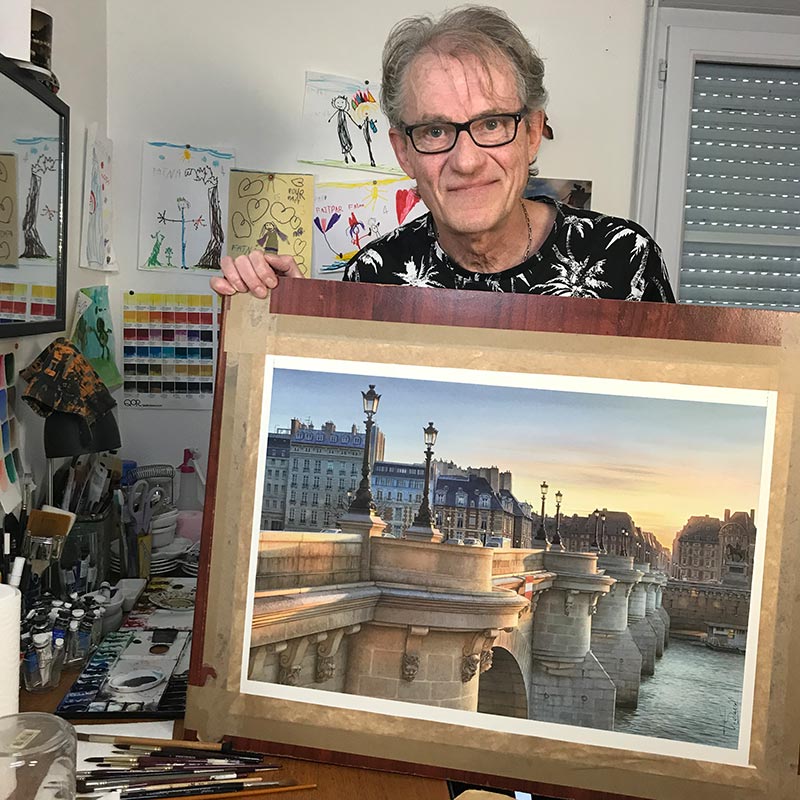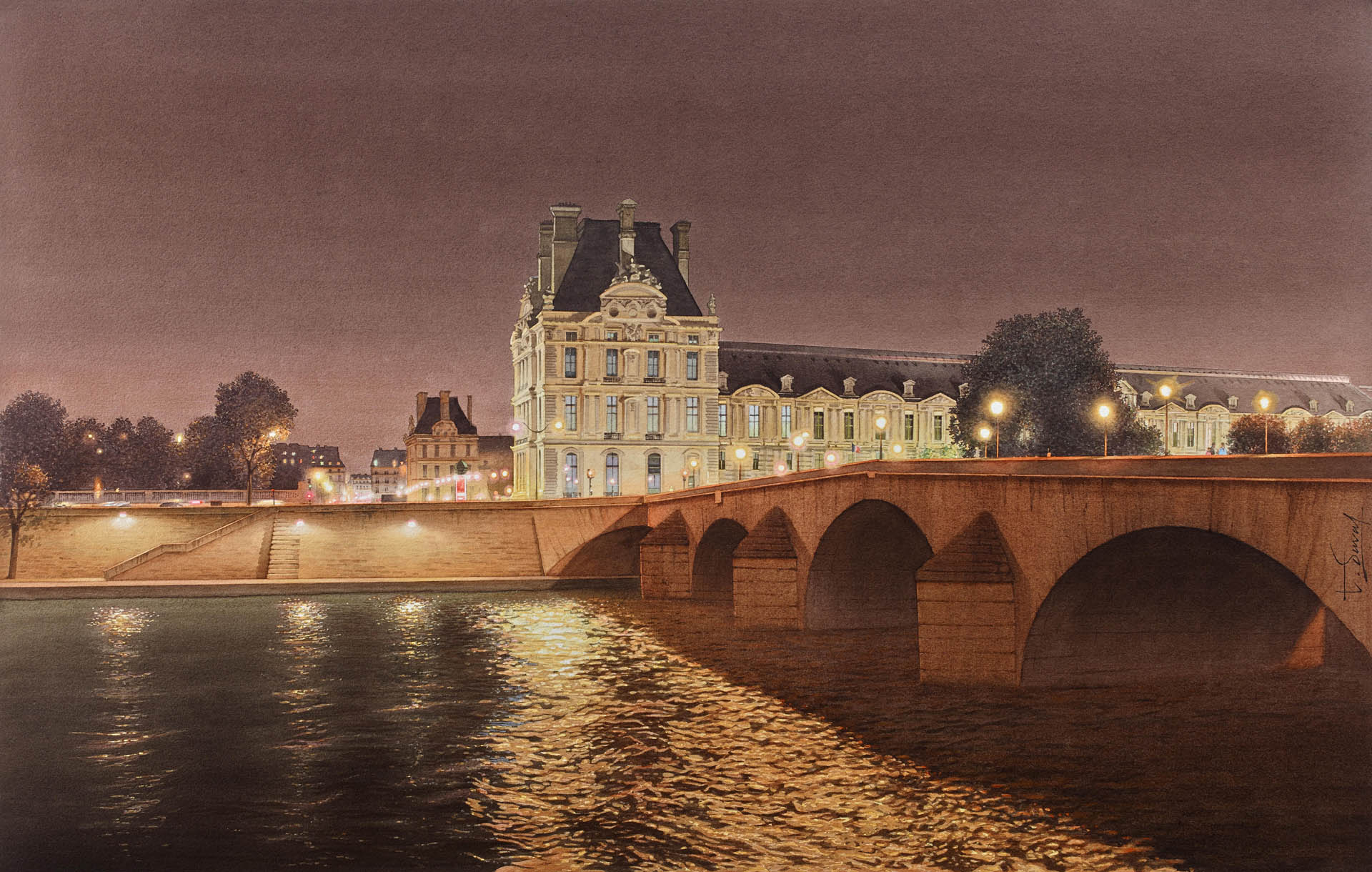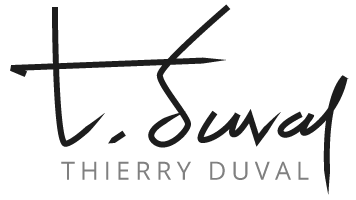Paris is a city of romance, infused with a timeless nostalgia – the same qualities that inspire my paintings. I have a compelling, visceral need to submerge myself, to lose myself, in its streets and squares. Which – given that I have no sense of direction whatever – is perhaps just as well.
The history of Paris is intimately linked with the great river that flows through it. The city’s original settlements grew up on the riverbanks and became linked by bridges laden with history. The bridges of the Seine – crossing places that are also symbols of the passage of time and of the transition from one life to another – form a recurrent theme in my work. I love their taut, soaring lines, the solidity and the graphic beauty of their arches. I am fascinated by the plays of light, shifting and dissolving, dancing and shimmering on their piers and roadways. I love the freshness of early mornings on the Pont Neuf, and the softness of late afternoons on the Hôtel du Nord footbridge, beneath the shade of the plane trees lining the Canal Saint Martin. I love to wander along the embankments crowded with bouquinistes’ stalls, those ‘ideas merchants’, as they used to be known. When the sun goes down, I love the exhilarating nights on the Passerelle des Arts, when the Seine is set alight with the ochres and golds of sunset.
In contrast with the bustle and movement of the city’s bridges, there are other places in Paris where time seems to have stood still, to hang motionless and unchanging. Place de Furstenberg, in the 6th arrondissement, is a charming little square planted with four spreading paulownias, its romantic looks further accentuated at night in the glow of the five lanterns of its streetlamp. I have painted this inimitably Parisian square, so closely linked to the memory of the painter Delacroix who lived there, on numerous occasions. It was when I was a student at the Ecole des Arts Décoratifs that I discovered watercolour as a medium. Captivated immediately by its lightness and transparency, I have been in thrall to it ever since. I draw inspiration from the great artists of the Romantic era, and from their unique ability to capture the effects of light. I love to paint that fleeting twilight moment when day seeps into night, when the dusk is filled with warm reflections and the shadows in the streets begin to lengthen. The changes in the light as day fades into night hold an endless fascination for me. Especially when the light wanes and the apartments of Paris are lit up here and there in blue, cool green, ochre and white, the streetlamps are haloed in a soft glow, and the city’s monuments sparkle as evening deepens into night. All these splashes of colour are so many flashes of light, illuminating my paintings and endowing them with movement and life.
Delacroix and Turner, Caspar David Friedrich and Edward Hopper have inspired me with their vision and techniques; but my paintings are influenced just as much by the old masters as by modern photography and hyperrealism. I often take photographs of my paintings when I am working on them, as being able to view them fixed on my computer screen gives me the distance I need to alter the composition and put the finishing touches to it. It enables me to frame them differently, to try out different depths of colour, to take out some elements of the composition and add in others.

I invariably work from photographs, which I take on long walks through the city, wandering and watching for hours at a time, in my constant quest for the magical light of Paris. Then comes my work in the quiet of my studio, with my music and my cats: painstaking, almost monastic work, with each of the larger paintings taking four weeks of seven-hour days to complete. As my work evolves, the constant theme linking all my paintings remains the light. I set out to capture the early morning light on the Quai des Orfèvres, the dramatic effects of contre-jour and the early afternoon sun, the illuminations of Paris by night, the lights of cafés, streetlamps, traffic lights and car headlights. In my paintings I strive endlessly to capture the special light of Paris and its region, the unique light that bathes the capital’s monuments and makes the stone of its façades and the lead of its roofs sing, and that celebrates with dazzling élan the architecture and the history of the ‘City of Light.
Paris est une ville romantique, intemporelle et nostalgique, comme l’est ma peinture. J’ai un besoin viscéral de m’y plonger, de m’y perdre ! Et comme je n’ai aucun sens de l’orientation, cela tombe bien…
L’histoire de Paris est intimement liée au fleuve qui la traverse. Elle a grandit sur chaque rives de la Seine que relient des ponts chargés d’histoire. Le pont est un sujet récurant dans mon travail. Lieu de franchissement, il symbolise aussi l’écoulement du temps, le passage d’une vie à l’autre. J’aime les lignes tendues, élancées, la stabilité et le graphisme des arches de ceux qui enjambent la Seine. Je suis fasciné par les jeux de cette lumière qui mute, meurt ou se ravive sur leurs piles et tabliers. J’aime la fraîcheur des petits matins sur le Pont-Neuf, la douceur des fins d’après-midi à l’ombre des platanes qui bordent le canal Saint-Martin qu’enjambe la passerelle de l’hôtel du Nord. J’aime flâner le long des quais encombrés des étals des bouquinistes, ces « marchants d’esprits » disait-on. Lorsque le soleil se couche, j’aime les nuits joyeuses sur la passerelle des Arts, les crépuscules colorés d’ocres et d’or qui embrasent la Seine.
À l’inverse des ponts où la vie passe et bouge, il y a des lieux à Paris où le temps semble figé, comme suspendu. Par exemple, la place Furstenberg dans le 6e arrondissement, charmante placette plantée de quatre Paulownias qui, au printemps, lui confèrent un aspect particulièrement romantique qu’accentue l’éclairage nocturne d’un lampadaire à cinq globes. J’ai peint de nombreuses fois ce lieu si typiquement parisien, intimement lié au souvenir de Delacroix qui l’habita.
Alors étudiant aux Arts Décoratifs j’ai découvert l’aquarelle. Immédiatement séduit par ce médium et sa légèreté, il a nourri une passion qui ne m’a jamais quittée. Je m’inspire des grands maîtres du Romantisme et de leur rendu si particulier des lumières. J’aime peindre ce moment « entre chiens et loups », lorsque le jour fait place à la nuit, ce moment fugace où la lumière se réchauffe et les ombres s’allongent dans les rues. Ces transitions lumineuses qui rythment la journée me fascinent. En particulier lorsque le jour décline et que les appartements parisiens s’allument ça et là de bleu, de vert froid, d’ocre et de blanc. Les candélabres se réveillent progressivement dans un léger halo. Les monuments de la capitale scintillent dans la nuit naissante. Toutes ces taches colorées sont autant de sources lumineuses qui vont éclairer, rythmer et donner vie à ma peinture.

Delacroix, Turner, Friedrich, mais aussi Hopper m’ont ouvert des voies, des techniques picturales, mais ma peinture s’inspire des grands maîtres anciens tout autant que de modernité photographique, d’hyperréalisme. Je photographie souvent une œuvre en cours de réalisation car la voir ainsi figée sur l’écran de mon ordinateur me donne le recul nécessaire pour amender et parfaire mon dessin. Je teste des cadrages, des saturations, j’enlève ou j’ajoute des éléments dans la composition. Je travaille uniquement d’après mes photos. Elles sont le fruit de longues promenades, d’errances et de nombreuses heures d’observation, de quête perpétuelle de la lumière magique de la capitale. Vient ensuite le travail en atelier, au calme, avec ma musique et mes chats. Un travail minutieux, quasi monastique puisque chaque œuvre nécessite quatre semaines de travail, pour les plus grands formats, à raison de sept heures de travail par jour… Si mon travail évolue, la lumière reste le fil rouge de ma peinture. Je cherche à saisir celle du petit matin sur le quai des Orfèvres, celle – violente – des contre-jours et débuts d’après-midi, les lumières de la nuit parisienne, des cafés, des candélabres, des feux de signalisation, celles aussi des phares de voitures… Inlassablement, ma peinture tente de restituer cette lumière si particulière de l’Île de France, celle qui baigne Paris, fait chanter la pierre de ses façades et le zinc de ses toitures, célébrant avec éclat l’architecture et l’histoire de cette « Ville lumière ».
